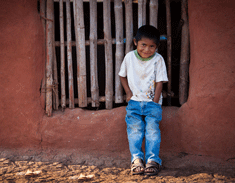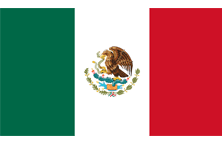Mexico is the fifth largest country in the Americas by total area and the 13th largest independent nation in the world. It is bordered on the north by the United States; on the south and west by the Pacific Ocean; on the southeast by Guatemala, Belize, and the Caribbean Sea; and on the east by the Gulf of Mexico.
Population:
Approximately 113 million
Capital:
Mexico City is the country's largest city as well as its most important political, cultural, educational and financial center.
Demographics:
The large majority of Mexicans can be classified as "Mestizos", meaning in modern Mexican usage that they identify fully neither with any indigenous culture nor with a particular non-Mexican heritage, but rather identify as having cultural traits and heritage incorporating elements from indigenous and European traditions.
Racial and ethnic composition in Mexico (Encyclopedia Britannica)
Race/Ethnicity
Mestizo 65.0%
Amerindian 17.5%
White 16.5%
Other 1.0%
Primary Language:
The country has the largest Spanish-speaking population in the world with almost a third of all Spanish native speakers.
Mexico is additionally home to a large number of indigenous languages, spoken by some 5.4% of the population – 1.2% of the population are monolingual speakers of an indigenous language. The indigenous languages with most speakers are Nahuatl, spoken by approximately 1.45 million people, Yukatek Maya spoken by some 750,000 people and the Mixtec and Zapotec languages each spoken by more than 400,000 people.
In addition to the indigenous languages, other minority languages are spoken by immigrant populations, such as the 80,000 German-speaking Mennonites in Mexico, and 5,000 the Chipilo dialect of the Venetian language spoken in Chipilo, Puebla.
Religion:
The 2010 census by the Instituto Nacional de Estadística y Geografía (National Institute of Statistics and Geography) gave Roman Catholicism as the main religion, with 83% of the population, while 10% (10,924,103) belong to other Christian denominations, including Evangelicals (5%); Pentecostals (1.6%); other Protestant or Reformed (0.7%); Jehovah's Witnesses (1.4%); Seventh-day Adventists (0.6%); and members of The Church of Jesus Christ of Latter-day Saints (0.3%). 172,891 (or less than 0.2% of the total) belonged to other, non-Christian religions; 4.7% declared having no religion; 2.7% were unspecified.
Economy:
Mexico has the 14th largest nominal GDP and the 10th largest by purchasing power parity. Mexico's Gross Domestic Product (GDP) in purchasing power parity (PPP) was estimated at US $1,748.908 billion in 2012, and $1,231.642 billion in nominal exchange rates. Mexico is now firmly established as an upper middle-income country. According to Goldman Sachs, by 2050 Mexico will have the 5th largest economy in the world.
From the late 1990s onwards, the majority of the population has been part of the growing middle class. But from 2004 to 2008 the portion of the population who received less than half of the median income has risen from 17% to 21% and the absolute levels of poverty have risen considerably from 2006 to 2010, with a rise in persons living in extreme or moderate poverty rising from 35 to 46% (52 million persons).
Government:
The United Mexican States are a federation whose government is representative, democratic and republican based on a presidential system according to the 1917 Constitution. The constitution establishes three levels of government: the federal Union, the state governments and the municipal governments. According to the constitution, all constituent states of the federation must have a republican form of government composed of three branches: the executive, represented by a governor and an appointed cabinet, the legislative branch constituted by a unicameral congress and the judiciary, which will include called state Supreme Court of Justice. They also have their own civil and judicial codes.
Most Importantly:
The people of Mexico are BEAUTIFUL! Our attempt with this website is to show the beauty of the people of Mexico and encourage you to purchase a print or book to serve it’s people.
Learn more:
Find out more interesting facts about Mexico by visiting http://en.wikipedia.org/wiki/Mexico

